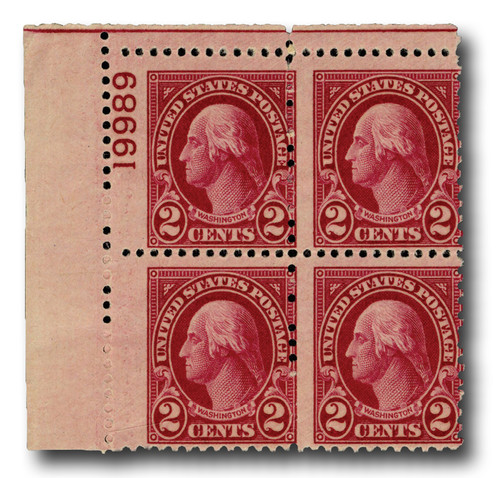
# 634b - 1926-28 2c Washington,carmine lake (I)
U.S. #634b
1926-28 Rotary Stamp
2¢ Washington Carmine Lake
Perforated 11 x 10.5
Earliest Known Use: December 20, 1929
First City: Washington, DC
Printing Method: Rotary Press
Perforation: 11 x 10 ½
Color: Carmine lake
The 1926-28 rotary stamps used the designs of the flat plate Series of 1922-25. The original 2¢ Washington was printed in 1926 in carmine. To meet additional need, it was printed again in 1929 in carmine lake, resulting in #634b, which is the scarcer of the two.
Perfecting Perforations on Rotary Stamps
When the Bureau began printing sheets on the rotary press, they found 11 gauge perforations were too fine, causing the stamps to separate prematurely. This resulted in the perforations being changed back to 10 gauge perforations, which had first been used in 1915. Once again, objections were raised, and the Bureau began looking for a way to perforate the stamps so they were strong enough to resist premature separation, yet fine enough to be separated without difficulty. The solution was found in a compromise that resulted in a new perforation – the 10 1/2 gauge.
This perforation seemed to please everyone and was adopted as the new standard for rotary press sheets. In the words of Linn’s author Gary Griffith, the 1926-28 Compound Perforation rotary stamps represent “if not perfection, then at least a high degree of achievement...”
U.S. #634b
1926-28 Rotary Stamp
2¢ Washington Carmine Lake
Perforated 11 x 10.5
Earliest Known Use: December 20, 1929
First City: Washington, DC
Printing Method: Rotary Press
Perforation: 11 x 10 ½
Color: Carmine lake
The 1926-28 rotary stamps used the designs of the flat plate Series of 1922-25. The original 2¢ Washington was printed in 1926 in carmine. To meet additional need, it was printed again in 1929 in carmine lake, resulting in #634b, which is the scarcer of the two.
Perfecting Perforations on Rotary Stamps
When the Bureau began printing sheets on the rotary press, they found 11 gauge perforations were too fine, causing the stamps to separate prematurely. This resulted in the perforations being changed back to 10 gauge perforations, which had first been used in 1915. Once again, objections were raised, and the Bureau began looking for a way to perforate the stamps so they were strong enough to resist premature separation, yet fine enough to be separated without difficulty. The solution was found in a compromise that resulted in a new perforation – the 10 1/2 gauge.
This perforation seemed to please everyone and was adopted as the new standard for rotary press sheets. In the words of Linn’s author Gary Griffith, the 1926-28 Compound Perforation rotary stamps represent “if not perfection, then at least a high degree of achievement...”








